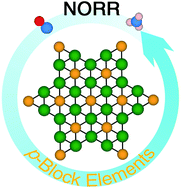Nitric oxide reduction reaction for efficient ammonia synthesis on topological nodal-line semimetal Cu2Si monolayer†
Abstract
It is imperative to remove NO from the exhausted gas, and an electrochemical NH3 synthesis via N2 reduction still suffers from low activity and selectivity. It is of interest that direct electrochemical NO reduction reaction (NORR) is regarded as an alternative approach to remove NO and synthesize NH3 simultaneously. In this work, the NORR activity of nodal-line semimetal Cu2Si monolayer is evaluated from first-principles calculations. In particular, NH3 formation occurs spontaneously due to proper NO adsorption, exhibiting excellent NORR activity of the Cu2Si monolayer. In addition, the importance of introducing p-block elements in boosting electrocatalytic performance is further demonstrated by comparing the NORR activities on clean Cu(111) and Si-doped Cu(111) surfaces. It concludes that Si atom can reduce the NO adsorption strength and thus facilitate the protonation of *NO, removing the thermodynamic energy barrier. It is, therefore, an indication that p-block elements can modulate the surface chemistry and physical properties, and introducing p-block elements onto/into the catalyst surface can be an effective strategy to boost the activity. In conclusion, our results not only identify an efficient NORR electrocatalyst, but also open a new avenue for the development of quantum topological material-based electrocatalysts of high efficiency.



 Please wait while we load your content...
Please wait while we load your content...